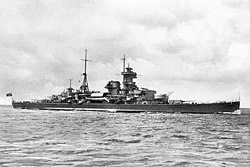This article needs additional citations for verification .(May 2022) |
| |
|---|---|
 Admiral Hipper | |
| Operational scope | Naval operation |
| Planned by | Kriegsmarine |
| Objective | Destruction of Convoy JW 51B |
| Date | Began 30 December 1942 |
| Executed by | Group Command North |
Operation Rainbow (Unternehmen Regenbogen) was a 1942 sortie into the Arctic Ocean by warships of the Nazi German Kriegsmarine (German Navy) during the Second World War. The operation culminated in the Battle of the Barents Sea.
